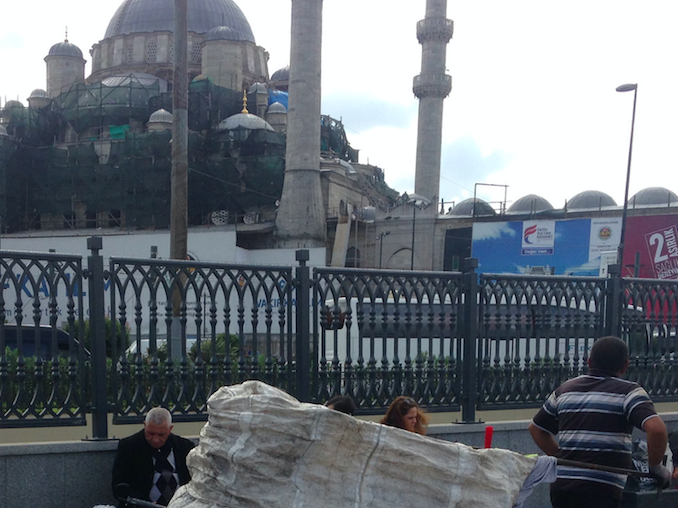
ISTANBUL — In 2013, an Iranian national living in Texas was sentenced to 25 years in prison for planning to assassinate the Saudi ambassador to Washington, D.C. The State Department alleged that Iran’s Al Quds force masterminded the terrorist plot. Although the bombing never took place and Iran denied any connection with the conspiracy, 92 US senators signed a letter calling on President Barack Obama to “crush Iran’s central bank” in retaliation.

On October 2 of this year, according to Turkish intelligence sources, Saudi authorities murdered dissident Saudi journalist Jamal Khashoggi inside its consulate here in Istanbul, Turkey. Many Turks are convinced that the reported torture and murder of Jamal Khashoggi was an act of terror aimed at intimidating Saudis from organizing opposition to the regime. Yet on this occasion, no high-level US official labelled it a terrorist plot. No senator has called for crushing the Saudi central bank.
Hmmmm. Once again, US leaders label violence carried out by enemies as terrorism. The same violence carried out by allies is ignored or downplayed.
Death in Istanbul
Khashoggi, a permanent US resident writing a Washington Postcolumn, entered the Saudi consulate in Istanbul and never left. At first, Saudi leaders, including Crown Prince Mohammed bin Salman, denied any foul play. But they later floated a story about how Khashoggi may have been killed in an interrogation gone terribly awry, and Trump offered up unsubstantiated speculation that he was killed by a “rogue agent.”
But that version doesn’t hold up either. Before the murder, Saudi leaders sent a 15-man hit squad to Istanbul that included several of the crown prince’s top security officers and an autopsy expert carrying a bone saw. Turkish media reported that audio recordings show Khashoggi was horribly tortured, murdered, and then dismembered.
It’s likely the assassination was ordered by the highest level Saudi leaders, including the crown prince. Saudi royals have regularly used terror to intimidate enemies. In 2013, I reported on their repression of mostly Shia Saudis in the eastern region of Qatif.
But both Democratic and Republican presidents largely ignore such brutal repression. They built a close alliance based on what are deemed to be US national interests—in reality, vast profits for US oil companies and weapons manufacturers, and support for US geopolitical policy in the region.
Saudis back terrorism
The Saudi leadership supported terrorist groups fighting the Soviet occupation of Afghanistan in the 1980s, for example, and funded Chechen terrorist attacksin Russia in the 2000s. I’ve reported on how Saudi Arabia providedmoney and arms to the al Qaeda affiliate in Syria, something Hillary Clinton also admitted, as revealed in a leaked memo.
While ignoring Saudi support for terrorism, the Trump Administration is happy to pegIran as the world’s “most prominent state sponsor of terrorism.”
“We will defeat radical Islamist terrorists such as ISIS and al-Qaeda, expand our agile counterterrorism toolkit to prevent future terrorist threats, deter emerging threats, roll back Iran’s global terrorist network, and ensure our country’s continued safety,” Trump has said.
The Trump Administration falsely links Shiite Iran with Sunni-based terrorist groups. In fact, Iran fought ISIS in both Iraq and Syria, and is no more linked to ISIS than Saddam Hussein had weapons of mass destruction. Iran has been just as much a victim of terrorism as a perpetrator.
Iran as victim of terrorism
Last month, twenty-nine Iranian soldiers and civilians were killed in the southwestern city of Ahvaz when men dressed in Revolutionary Guard uniforms opened fire on crowded parade ground bleachers. The Iranian government blamed ISIS for the attack and fired missiles into an ISIS controlled area of Iraq.
In 2017 ISIS attacked the Iranian parliament and the Imam Khomeini shrine in Tehran, killing twelve and wounding forty. Once again, ISIS was held responsible.
Undoubtedly, Iran has used terrorist tactics to advance its religious and geopolitical goals. Just this month, Belgian and French police arrested an Iranian diplomat and civilian couple for plotting to bomb a Mujahideen-e-Khalq event in Paris. The Mujahideen-e-Khalq is a right-wing cult opposed to Tehran. The invited guests at the event included Trump advisor Rudy Giuliani and former Speaker of the House Newt Gingrich. Iranian authorities strongly deny any Iranian involvement in the bomb plot. A trial has not yet been scheduled.
Iran does support groups that have used terrorist tactics, including the Lebanese Hezbollah and the Palestinian groups Hamas and Islamic Jihad. Many in the Middle East, however, view these groups as national liberation organizations fighting Israel. They see them as distinct from Al Qaeda and ISIS, which intentionally kill civilians as part of their strategy to ethnically cleanse the region and establish a dictatorial Islamic caliphate.
I don’t think anyone’s hands are clean when it comes to supporting terrorism. But on balance, Saudi Arabia has done more to promote terrorism than Iran. And don’t even get me started on US support for mujahideen in Afghanistan, contras in Nicaragua or terrorist groups in today’s Syria. But for that, you’ll have to await a future column.
Reese Erlich’s nationally distributed column, Foreign Correspondent, appears twice monthly in 48Hills. His book The Iran Agenda Today: The Real Story from Inside Iran and What’s Wrong with US Policyis now available. Follow him onTwitter, @ReeseErlich; friend him onFacebook; and visit his webpage.


